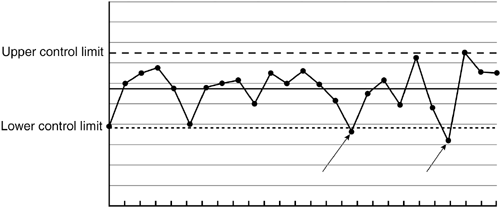25.3 Analyzing Metrics for Control and Improvement
| There is no reason to collect measurements if nobody is going to analyze them or act according to the results. Measurements must be collected over time, in order to calculate, say, the balance point and variation. This permits control of processes and their improvement. This section provides a brief introduction to the statistics used in process control and process improvement. Process control finds reasons for variations from the norm. Control over processes is gained by constantly analyzing new measurements in relation to expected values, to identify unexpected behavior. This may be revealed by a measurement that lies outside the normal variation, either positive or negative. An example might be a handling time for an event that is suddenly faster than normal. Is this because the configuration control board didn't do its work properly, is it an event that it has handled many times before, or is it some other reason? Process improvement changes reasons for the normal. This may be done by identifying what normal iswhere the balance point is and what the variation isthen ask oneself questions such as
A balance point may be the average time it takes for an event registration of a certain type to be handled. It may be worthwhile to find out if the handling process has bottlenecks that might be eliminated to decrease average handling time. StatisticsAll configuration management work is a series of processes, which can be followed over time. Statistics is the science of patterns; it also handles " chances " or "coincidences." You could say that statistics make the invisible visible or that they help understand the past, control the present, and forecast the future. However, you can prove almost anything with statistics if you want to, or if you're not careful. The following example illustrates the point. (The numbers are made up, but the orders of magnitude are correct.) In Denmark, we have 30 accidents each year on three-lane roads and 200 accidents a year on two-lane roads . Which type of road is more dangerous? There are, however, 30 kilometers of three-lane roads and 1,000 kilometers of two-lane roads. Which type of road is more dangerous? But the three-lane roads are used by 3,000 cars a year and the two-lane roads by 10,000 cars a year. Which type of road is more dangerous? Balance PointThere are three usual ways of finding the balance point in a group of measurements:
In the group of measurements 3, 5, 4, 7, and 5, the following can be calculated measurements:
The mean is affected by outliersvalues far away from the others. If the numbers represent children's ages, all the children can't be above average, but half of them will always be on or above the median. VariationWhat Is NormalAnything in nature has smaller or larger variations. The normal has wide limits, as the saying goesbut how wide? Depending on the type of measurements to analyze and control, the two most used calculations are
These values may be used to calculate so-called control limits for measurements under analysis. Control ChartsControl charts are graphical ways of looking at measurements, to detect if something goes wrong with the process for which the measurements are being collected. A control chart is useful for
There are many different types of control charts, depending on the series of measurements to analyze. Examples include
Figure 25-2 shows an average and range control chart, with the average, control limits, and value points over time. The two value points by the arrows are outside the lower control limit, and their causes should be investigated. Figure 25-2. Average and Range Control Chart Examples of indicators that would show the process out of control might include
Control charts provide a lot of information in an easily understandable way with a manageable amount of work, especially if statistical or other tools are used. |
EAN: 2147483647
Pages: 181
